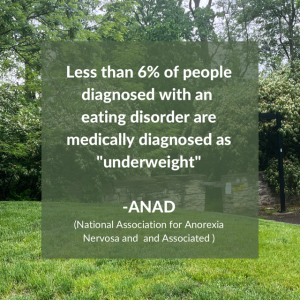
“Less than 6% of people with eating disorders are medically diagnosed as ‘underweight’” – National Association of Anorexia Nervosa and Associated Disorders (ANAD)
Let’s reflect on this statistic. There is still a widespread FALSE belief that eating disorders are visible and that it looks like someone in an emaciated or very thin body.
The statistic above tells us that more than 94% of people with an eating disorders are not medically “underweight.” This means eating disorders are not visible and cannot be determined simply by looking at someone. The belief that a body’s shape or size can help in determining the presence of an eating disorder is harmful. It prevents a lot of people from getting the help they need. Additionally, it leads to invalidating someone’s struggles if assumptions about the relationship with food are made based on body shape or size. I’ve heard countless stories about how professionals or loved ones say things such as, “you don’t look sick” or “you look good/healthy.”
This perpetuates the idea that most likely already exists in that person’s mind that they don’t have an eating disorder or they aren’t “sick enough.” It may lead someone to continue engaging in behaviors until it is “noticeable” or people start to express concerns. It also keeps someone struggling in denial, and prevents them from getting help or results in them refusing treatment until they “look” like they have an eating disorder. Meanwhile, the eating disorder is taking over control, which will make the recovery process and complications of eating disorder behaviors more intense and severe.
This stereotype is also detrimental because it continues to put the focus on the way the body looks rather than having concern for someone’s relationship with food and their thoughts, as well as feelings about their body.
There is no way to know if someone has an eating disorder unless you ask them about eating disorder behaviors, thoughts, and feelings. I hope that this statistic and other eating disorder research and advocacy will help eliminate the stereotype that you can “see” an eating disorder. Eating disorders are an internal struggle and require inquisition and understanding.
As a way to practice letting go of this stereotype and stigma, begin reminding yourself that you never know what someone else is struggling with by looking at them. Looking at a person won’t tell us what pain they are experiencing, what brings them joy, if they are struggling with depression or an eating disorder, or who they love.
Be willing to show compassion and understanding to all people and not make judgments or assumptions. You can only begin know and understand someone by hearing their story.
Eating disorder statistics: General & Diversity stats: ANAD. ANAD National Association of Anorexia Nervosa and Associated Disorders. (2023, April 4). Retrieved April 18, 2023, from https://anad.org/eating-disorders-statistics/
Flament, M., Henderson, K., Buchholz, A., Obeid, N., Nguyen, H., Birmingham, M., Goldfield, G. (2015). Weight Status and DSM-5 Diagnoses of Eating Disorders in Adolescents From the Community. Journal of the American Academy of Child & Adolescent Psychiatry, Vol. 54, Issue 5, 403-411. https://www.jaacap.org/article/S0890-8567(15)00076, 3/fulltext#relatedArticles
